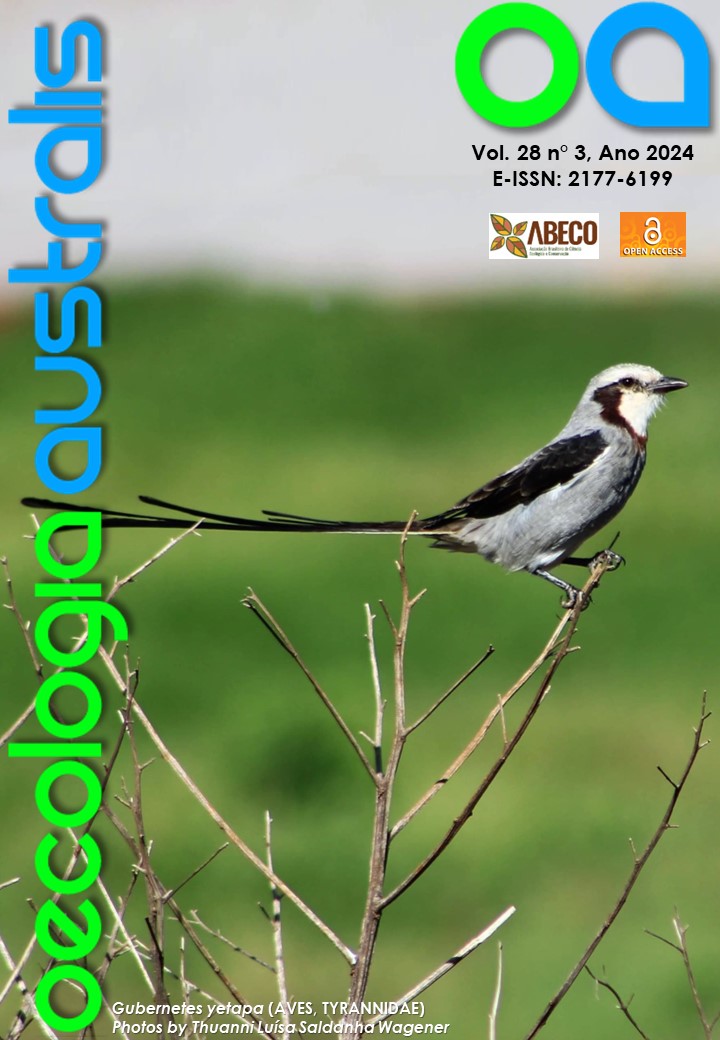VARIAÇÃO BIOMÉTRICA E REPRODUÇÃO DO BIVALVE Anomalocardia flexuosa (BIVALVIA; VENERIDAE) EM DIFERENTES ÁREAS DE PESCA
Biometria do bivalve Anomalocardia flexuosa (Bivalvia; Veneridae)
DOI:
https://doi.org/10.4257/oeco.2024.2803.03Abstract
O bivalve Anomalocardia flexuosa é um dos principais recursos pesqueiros utilizados na pesca artesanal no Nordeste brasileiro. O objetivo deste estudo foi identificar as variações reprodutivas e biométricas da concha do A. flexuosa em diferentes áreas de pesca no estuário dos rios Goiana e Megaó, no Nordeste do Brasil, gerando informações para subsidiar estratégias para a conservação do bivalve. Foram utilizados três pontos de amostragens bimestrais, onde o P1 foi caracterizado por uma pesca manual; P2 pela presença de uma pesca mais intensiva, com uso de apetrechos de pesca de menor potencialidade; e P3 com alta intensidade de pesca com utensílios que potencializam a capacidade de coleta, como puçá de cabo longo. Para cada espécime coletado, o comprimento da concha, altura da concha, largura da concha, peso total e peso úmido foram medidas para avaliar os padrões de tamanho dos organismos e o rendimento da carne. Também foram realizadas análises histológicas para identificação dos estágios reprodutivos. A partir da análise de 5.188 espécimes capturados, observou-se que o P3 apresentou os menores tamanhos corporais, podendo ser reflexo da sobrepesca no local. Os modelos de crescimento foram isométricos para as medidas da concha, e alométrico negativo para a relação entre comprimento e peso no P1 e P2, e alométrico positivo no P3. Foram realizadas as fotomicrografias de 32 espécimes para o P1, onde 45% foram machos, 48% fêmeas e 7% não identificados; e 25 espécimes no P3, sendo 12% machos, 52% fêmeas e 36% não identificados. Referente aos estágios reprodutivos, os mais representativos foram os estágios “em maturação” e “maturo”. Devido às evidências de sobrepesca no P3 e alto rendimento potencial nos outros pontos, destacamos a necessidade de ações eficientes de gestão que mitiguem os impactos provenientes da sobrepesca, como a rotação das áreas de pesca.
BIOMETRIC VARIATION AND REPRODUCTION OF THE BIVALVE Anomalocarida flexuosa (BIVALVIA; VENERIDAE) IN DIFFERENT FISHING AREAS
The bivalve Anomalocardia flexuosa is one of the main fishing resources utilized in artisanal fishing in northeastern Brazil. The objective of the study was to identify the reproductive and biometric variations in the A. flexuosa shell across different fishing areas in the estuary of the Goiana and Megaó rivers in Northeast Brazil, generating information to support strategies for its conservation. Three bimonthly sampling points were used, with P1 being characterized by manual fishing; P2 by more intensive fishing than P1, with the use of less potent fishing gear; and P3 by high-intensity fishing with tools that enhance the collection capacity, such as long-handled nets. For
each specimen collected, shell length, shell height, shell width, total weight wet weight, and meat yield were measured to assess size patterns of the organisms and meat yield. Histological analyses were also conducted to identify the reproductive stages. From the analysis of 5,188 captured specimens, it was observed that with P3 presented the lowest body sizes, possibly reflecting overfishing at the site. Growth models were isometric for shell measurements and negative allometric for the length-weight relationship in P1 and
P2, and positive allometric in P3. Photomicrographs were taken of 32 specimens for P1, withe 45% males, 48% females and 7% unidentified; and 25 specimens in P3, 12% males, 52% females and 36% unidentified. Regarding reproductive stages, the most representative were the “maturation” and “mature” stages. Due to the evidence of overfishing in P3 and high potential yield in other points, we highlight the need for efficient management actions that mitigate the impacts of overfishing, such as rotation of fishing areas.


